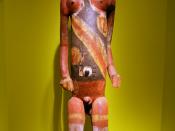Early African American's Slavery Impacts
During the early 16th century the Ibo Tribe came along and took place in South-Eastern Nigeria, Africa. There were about 8 million people located there during this time. Many believe Ibo was originated about 100 miles north of the Nigeria and Benue River. They share many unique things with their neighbors the Bini, Igala, Yoruba, and Idoma, with the split between them that occurred probably occurring about five and six thousand years ago. The first Igbo in the region may have moved onto the Awka-Orlu plateau about four and five thousand years ago, before the emergence of agricultural practices. The earliest surviving Igbo art forms are from the 10th century (Igbo Ukwu), and the fine quality of copper alloy which lead to the conclusion that the Igbo society had already achieved a level of technology rivaling contemporary Europeans. There neighbors were IbIbIo, Ijo, Ekoi, Igala, Idoma, and Nupe.
These people had a way of showing their art and it was to carve and use masks but every village had its own meanings for these masks and they were also created to honor different gods. The majority of people located here were farmers and would staple crop is yam, and its harvesting is a time for great celebration. They are able to produce so many yams that they are able to export it to their neighbors. To add to that, they even harvest the fruit of the palm tree, which is processed into palm oil, and exported to Europe in large quantities, making it a very profitable cash crop. The Ibo tribe had more than 120 languages and dilects spoken by hundreds of different village groups, it would be reductionism to attempt to illustrate the traditional religious practices of the Igbo as a whole. Before...


